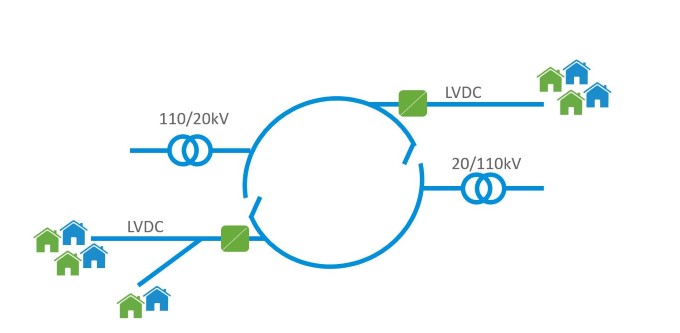
Ensto LVDC Microgrid - Low Voltage Direct Current solution maximizes capacity and minimizes power losses
LVDC-article part 2/3
The first LVDC article told how LVDC Microgrid offers solution for the most relevant problems, like lack of capacity, power loss, poor quality of electricity, unbalances and variations of voltage or frequency.
Future production, loads and storage are increasingly based on DC current instead of AC current. Most of that happens in distribution networks, which makes the use of LVDC, with all its benefits, the best solution technically and economically.
Our LVDC Microgrid solution for modern utilities is built on a 1500V DC (± 750V) nominal voltage line as a backbone. With that definition, all installations can be made according to the low-voltage electrical installations standards, which simplifies both configuration, staffing and execution of the projects. The connectivity with DC mode solar power and local energy storages is straightforward as well.
The LVDC branch of distribution network creates a microgrid, which enables on-grid and off-grid operation, and can act as a virtual power plant towards the grid giving, when needed, both frequency support and voltage support with reactive power control. However, there are also other reasons to make the move.
“Why not enjoy from six to ten times more distribution capacity with already-existing low voltage overhead lines or underground cables? Or how about reducing the losses caused by non-billable usage to zero?” asks Jussi Vanhanen, mentioning just a few benefits concerning especially those areas, where the demand for electricity has increased rapidly.
Microgrid helps to keep balance
Basic distribution network covering the complete territory is built with a 20kV AC medium voltage (MV) grid that is fed from a high voltage (HV) transmission network of 110kV AC.
The Ensto LVDC Feeder Station connects to the 20kV MV grid through a transformer, inverts the power to +-750V DC and connects the customers via LVDC. Now, the MV grid sees the LVDC microgrid, with its energy using customers, as a single symmetrical three-phase load with very low total harmonic distortion (THD). This is how the microgrid can support the MV grid voltage.
A distribution network branch with LVDC releases the MV AC grid from reactive power that customers produce or consume. This way it gives better control of reactive power on the MV grid side, acting as a static synchronous compensator (STATCOM). It can even be set to produce or consume reactive power to compensate another area of the MV grid. As a result, power losses are reduced and transmission efficiency increased.
Ensto LVDC Feeder Station functions bidirectionally, which opens the way to integration of a large number of local distributed power production entities, like solar, connected along the LVDC backbone.
The next article tells about different solutions and units for the LVDC Microgrid.
Additional information: Jussi Vanhanen, Director, LVDC, Ensto Utility Networks
Jussi.Vanhanen(at)ensto.com or from local Ensto company